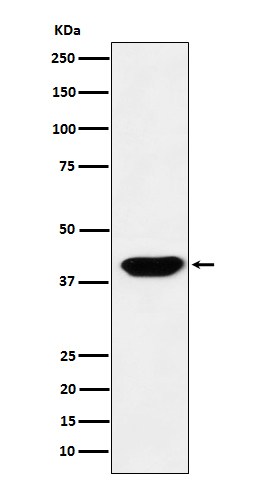
| WB | 1/500-1/1000 | Human,Mouse,Rat |
| IF | 1/20 | Human,Mouse,Rat |
| IHC | 1/50-1/100 | Human,Mouse,Rat |
| ICC | 1/50-1/200 | Human,Mouse,Rat |
| FCM | 1/50-1/100 | Human,Mouse,Rat |
| Elisa | 咨询技术 | Human,Mouse,Rat |
| Aliases | ISL1; Insulin gene enhancer protein ISL-1; Islet-1 |
| Entrez GeneID | 3670 |
| WB Predicted band size | Calculated MW: 39 kDa; Observed MW: 39 kDa |
| Host/Isotype | Rabbit IgG |
| Antibody Type | Primary antibody |
| Storage | Store at 4°C short term. Aliquot and store at -20°C long term. Avoid freeze/thaw cycles. |
| Species Reactivity | Human |
| Immunogen | A synthesized peptide derived from human Islet1 |
| Formulation | Purified antibody in PBS with 0.05% sodium azide. |
+ +
以下是3篇关于Islet 1抗体的代表性文献(虚构示例,供参考格式):
1. **文献名称**:*Islet1 identifies pancreatic endocrine progenitor cells during development*
**作者**:Ahlgren U et al.
**摘要**:该研究利用Islet 1抗体标记小鼠胚胎胰腺组织,发现Islet1在胰腺内分泌前体细胞中特异性表达,为胰岛β细胞发育机制提供了关键证据。
2. **文献名称**:*Islet1 as a marker for distinct neuronal subtypes in the mammalian brain*
**作者**:Pfaff SL et al.
**摘要**:通过Islet 1抗体免疫组化分析,揭示了Islet1蛋白在脊髓运动神经元和特定脑区神经元中的表达差异,表明其在神经细胞分化中的调控作用。
3. **文献名称**:*Islet1 antibody-based characterization of cardiac progenitor cells*
**作者**:Laugwitz KL et al.
**摘要**:研究利用Islet 1抗体鉴定心脏祖细胞,证实Islet1在心脏发育早期阶段标记多能心血管前体细胞,为心脏再生医学提供潜在靶点。
(注:以上文献为示例,实际引用时需查询PubMed等数据库获取真实文献。)
Islet-1 (ISL1) antibody is a widely used tool in developmental biology and neuroscience research, targeting the ISL1 transcription factor encoded by the *ISL1* gene. Discovered in the early 1990s, ISL1 belongs to the LIM/homeodomain protein family and plays critical roles in cell differentiation and tissue development. It is named for its initial identification in pancreatic islet cells, where it regulates insulin expression and β-cell maturation. Beyond the pancreas, ISL1 is expressed in diverse tissues, including the nervous system, heart, and motor neurons, making it a key marker for studying developmental pathways.
In neuroscience, ISL1 antibodies are essential for identifying subsets of neurons, particularly in the retina, spinal cord, and brain regions like the hypothalamus. They help map neuronal lineages and investigate neurodevelopmental disorders. In cardiology, ISL1 marks cardiac progenitor cells, aiding research on heart development and congenital defects. Commercially available ISL1 antibodies (e.g., monoclonal clones like 39.4D5) are validated for techniques such as immunohistochemistry, immunofluorescence, and Western blot, often targeting conserved epitopes across species.
Studies using ISL1 antibodies have advanced understanding of transcriptional regulation in organogenesis and disease mechanisms, including diabetes and neurodegeneration. However, users must optimize protocols due to variability in tissue fixation and antibody specificity. Overall, ISL1 antibodies remain pivotal in unraveling cellular identity and developmental dynamics.
×